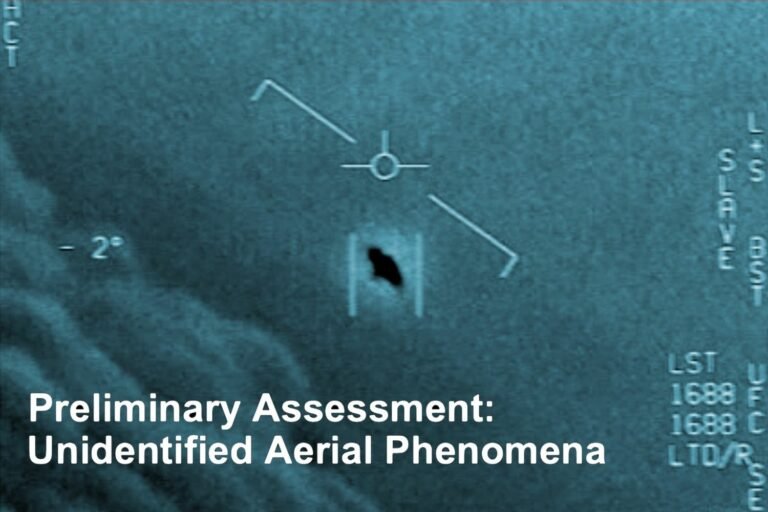On June 25, 2021, the Office of the Director of National Intelligence (ODNI) released a report on the early findings of the Navy’s Unidentified Aerial Phenomena Task Force (UAPTF). At just nine pages long, the brief report, entitled “Preliminary Assessment: Unidentified Aerial Phenomena” left much to be desired for the many readers anticipating specific details about the U.S. government’s collection of data about these aerial mysteries.
Nonetheless, the report did offer a few details about the frequency that unidentified aerial phenomena (UAP) are encountered by military personnel (a total of 144 incidents were cited in the report) along with the potential national security challenges they might present.
Days before the unclassified report appeared at the website of the ODNI last June, members of the House Intelligence Committee received a classified briefing detailing some additional information that was not included in the public version of the document.


While many details included in that classified version of the ODNI report remain withheld from the public, now a redacted copy of the full report has been obtained by researcher John Greenewald Jr. An expert on the use of the Freedom of Information Act (FOIA), Greenewald is the longtime operator of The Black Vault, a website showcasing the impressive trove of official documents he has obtained over the years, many of which relate to the U.S. government’s collection of information about UAP.
Greenewald called his latest acquisition “a small triumph in the effort to get transparency on a hot topic issue,” adding that rather than a typical FOIA request, the present effort resulted from the issuance of a Mandatory Declassification Review (MDR) case he filed within 24 hours of the release of the public version of the report.
“Although heavily redacted, the released classified UAP report does tell us quite a bit about how the U.S. military and government views this phenomenon,” Greenewald told The Debrief, also emphasizing “their reluctance to tell the public about it.”
Compared with the report made available to the public at the website of the ODNI last June, there are several notable differences in the complete version, which is slightly longer at a total of 17 pages. While much of the new information appearing in the version supplied to Greenewald was redacted before its release, it nonetheless provides enough context to offer new insights into the UAPTF’s investigations.
What follows is a breakdown of the primary differences between the reports, along with what can be gleaned from the new information that did make its way through redactions in the version obtained by The Black Vault.
What the Newly Released “Full” Report Reveals
On page two of the full version obtained by Greenewald, one of the earliest redacted portions appears to reference a government agency that was removed entirely from the unclassified public report from last June.
Following the release of the unclassified version of the report last summer, The Debrief noted that one agency that likely contributed to the ODNI assessment—the Central Intelligence Agency—was curiously absent.
“Notably missing as a contributor to the report is America’s principal foreign spy agency, the Central Intelligence Agency (CIA),” wrote Tim McMillan in a detailed analysis of the ODNI report published by The Debrief.
“Because the CIA’s activities are primarily bound to operating under Title 50, and outside U.S. soil, any UAP contributions by the spy agency would likely come during covert foreign intelligence collections,” McMillan wrote.
“An unwillingness to even acknowledge foreign spying on the unclassified version of the UAP report could be one reason why the CIA isn’t listed,” he added. “Conversely, it could also mean the CIA isn’t involved.” However, in light of the appearance of the short redaction on page two of the originally classified full version, it appears the CIA might have appeared in the original draft of the report.
Also early in the report within its Executive Summary section, minor differences in the wording also seem to provide more specifics about the sources of information on UAP incidents reviewed, although portions of that information are redacted.
One of the notable inclusions within the version of the report newly obtained by Greenewald is the revelation that many of the 144 UAP reports described in the report occurred during what the Navy calls “Range Fouler” incidents.
“Of the 144 USG reports,” reads a partially redacted portion of the full version of the report, apparently several incidents “originated from Navy ‘Range Fouler’ reports which provide basic information, such as the time, date, location, description, and what occurred during the event.”
According to an entry in the full version of the ODNI report’s appendix, Range Fouler is a term used primarily “by U.S. Navy aviators based on observations of UAP interrupting pre-planned training or other military activity in military operating areas or restricted airspace.” This definition, along with all other mentions of “Range Fouler” cases, were removed from the public version of the report.
Other differences between the two reports included details about the limitations of identifying UAP based on the design and functions of sensors on U.S. military platforms, particularly in relation to certain kinds of UAP, although the characteristics defining the specific variety of UAP cited in the full version of the report were also redacted.
“As a result, those sensors are not generally suited for identifying UAP which can be [REDACTED],” the full report states.


Also removed from the public version of the report had been a section on page five of the original, classified version which details the “most common shape described by military personnel in their reporting”. All details on these common UAP types, as well as a diagram in an additional Appendix section included in the full report displaying relevant images, remain redacted.
Page six of the full report also includes commentary by the UAPTF on altitudes where UAP were most frequently observed operating, which was removed before release of the public version. “Altitudes varied for these objects,” a portion of the document notes, “but frequently registered between [REDACTED] and [REDACTED] mean sea level (MSL).”
Among the other intriguing details that appear in the version of the report obtained by The Black Vault include various UAP behaviors associated with their apparent demonstration of advanced technology, as well as references to “recordings of radar displays” which appear to indicate observations by the UAPTF that related to the detection of radio frequencies (RF) in association with UAP events.
Unlike the public version of the ODNI report, which included no specifics about the 144 UAP incidents cited, the full version includes several sections with portions redacted that appear to convey descriptions of UAP observations by Navy pilots.
One account describes a Navy pilot who had flown in winds great enough that he had been “fighting to keep his aircraft in the airspace” while observing UAP nearby which, according to the pilot, remained unaffected and seemingly was able to hover motionless in such conditions.
Missing Details, and More Questions
Many redacted portions of the full version of the report raise intriguing questions. These include an entirely redacted pair of short paragraphs that appears before a section of the report outlining five potential explanatory categories for UAP, and similar redactions within various descriptions of the categories themselves.
Intriguingly, beneath the “Airborne Clutter” category description in the full report, the authors make references to objects that might fall into this category, along with references to statements provided by pilots. Here again, all specifics about these intriguing additional items constituting the UAPTF’s definition of “airborne clutter” are redacted.
Similar redactions appear beneath the “USG or Industry Developmental Programs” category, as well as “Foreign Adversary Systems”, suggestive of information reviewed by the UAPTF that could relate to such potential sources for some UAP.
Despite these intriguing redacted portions of the full report, there are also unredacted new portions that help provide an idea about which explanatory categories seem the least likely in terms of UAP reports being collected by the government. Beneath the “Natural Atmospheric Phenomena” category, the authors appear to confirm that virtually none of the UAP incidents studied by the UAPTF could be conclusively linked to natural atmospheric phenomena.
“Although we cannot definitively classify any UAP occurrences in our dataset as caused by atmospheric phenomena,” the authors state in the full version of the report, “we also cannot rule out the possibility that these factors may account for some of what pilots have observed.”
Toward the end of the document, a series of tables appearing in two additional Appendix sections omitted from the public version of the report bear the titles “Table 1. USG UAP Reports by [REDACTED] (144 total)” and “Table 2. UAP Detected by [REDACTED]”, as well as “COMMON SHAPES” and “LESS COMMON/IRREGULAR SHAPES”, all of which are mostly redacted.
To the frustration of many who will read it, one of the omitted Appendixes also features a sub-section entitled “Geospatial Intelligence (GEOINT)”, and while mostly redacted, nonetheless references “The images and videos captured” in an unredacted portion of the section’s first paragraph, an apparent reference to imagery possibly obtained by satellite or some similar means by the National Geospatial-Intelligence Agency (NGA).


The existence of such images has been addressed in the past by former Director of National Intelligence John Ratcliffe, who made references to satellite photos of UAP with Fox News host Maria Bartiromo in March 2021.
“Frankly, there are a lot more sightings than have been made public,” Ratcliffe told Bartiromo. “Some of those have been declassified, and when we talk about sightings, we’re talking about objects that have been seen by Navy or Air Force pilots, or have been picked up by satellite imagery that, frankly, engage in actions that are difficult to explain.”
Also included in one of the additional Appendix sections in the full version of the report is a section titled “Federal Bureau of Investigation Support of Attribution Efforts,” outlining Bureau’s apparently renewed role in supporting the government’s UAP investigations.
“Given the national security implications associated with potential threats posed by UAP operating in close proximity to sensitive military activities, installations, critical infrastructure, or other national security sites, the FBI is positioned to use its investigative capabilities and authorities to support deliberate DoD and interagency efforts to determine attribution,” this portion of the full report states.
While the full version of the report obtained by The Black Vault still leaves many questions—and even gives rise to new ones—the additional information it provides does present a clearer picture of the current U.S. government efforts toward resolving the UAP question.
“The release of this report, although discouraging with the level of redactions, does tell us a story worth pursuing,” Greenewald told The Debrief. “Some of this involves speculation, as we clearly just have to guess at what is behind some of this black.”
“But, it does give me hope that although we may never know the entire puzzle, with a little bit of blood, sweat, and tears, we can get a hold of quite a few of more pieces than we originally had.”
Micah Hanks is Editor-in-Chief and Co-Founder of The Debrief. Follow his work at micahhanks.com and on Twitter: @MicahHanks.

